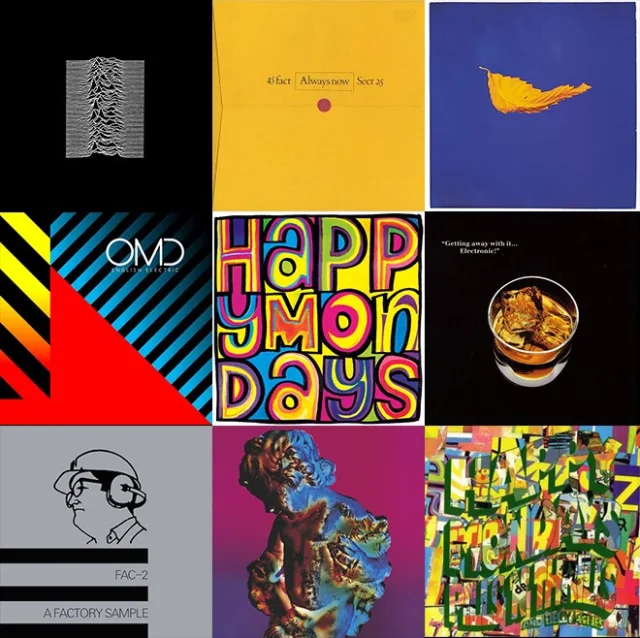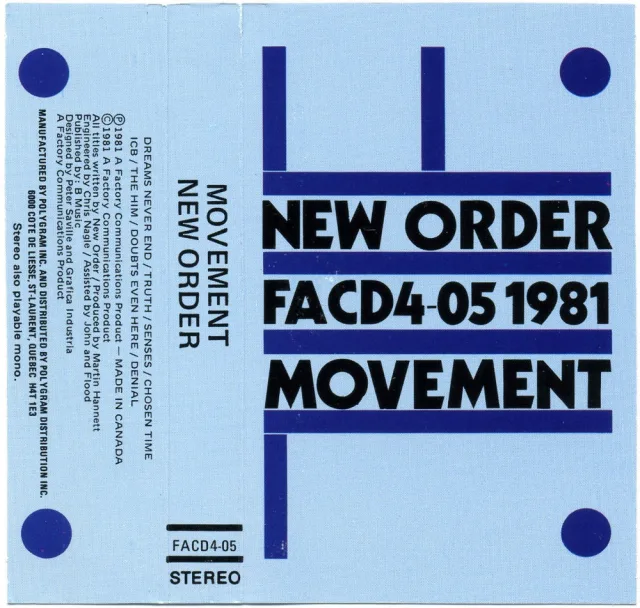Design systems in difficult places
This is Manchester. I grew up on the outskirts of Manchester. I have memories like this picture. Black and white. Snowing. Wildlings. It’s grim north of the wall.
But what this picture doesn’t show is the rich visual culture that Manchester had throughout the 80’s and 90’s. All that rain and grim weather makes people creative. It’s no accident most of the best music in the world came from the North West of England.

This is Tony Wilson. Tony was a journalist in Manchester, appearing on Look North West as a roving reporter. I have lasting memories of his wind-swept hair, stood in a gaudy cagoule talking to a farmer on some moor somewhere. He was on telly every evening at teatime when Look North West was an ‘appointment to view’ (as they call it in telly-land) across the region. But as well as being a journalist, Tony was also involved in Factory Records, founding it with Alan Erasmus in 1978. Factory went on to define an era of music in the 80’s and 90’s signing bands such as Joy Division, New Order, and the Happy Mondays. I’m not a big fan of the music, but of the graphic design produced at the time.


This work was everywhere in Manchester. On every street corner. In every record shop. In every music shop. There were posters, fliers, newspapers, TV adverts. The hum of the city became entwined with the output of Factory. And, without really noticing it, started to take on this DNA. It became Manchester’s design system. It’s visual life-blood.
Imposing order
The challenge with any design system is they normally don’t work, don’t get adopted, don’t grow or get used if they are imposed top-down without an awful lot of consultation. Like any language, they have to be adopted by the masses through continued daily use. The tricky thing for us designers is that is rarely how we’re engaged to create these things.
Normally the brief goes something like this:
We’d like you to design us a living style guide (replace with ‘pattern library’, ‘design language’, ‘brand guidelines’, ‘identity’). We’ll then use that to provide consistency to our entire product range – of which we’d like you to help us.
Now, this works in some circumstances if control is maintained by a marketing department or brand manager. But, it’s my experience, that unless design is valued then control is absent. Nobody has the authority to own this. They just have some budget and see a problem that needs addressing, but do not have the money, authority or organisational environment to make this work succeed. So what do you do then?
Well, you just do it anyway. But over the years – taking some inspiration from my home town – I have a few principles…
1. Repeat yourself consistently
Let’s get one thing out of the way first. Meetings are not bullshit. Suggesting that is actually bullshit. Meetings – where people talk and resolve things, plan, decide – are probably the most important thing you can do to get a design system off the ground in a difficult place.
Remember, you have no authority. Your client, or stakeholder, has no authority. You’re doing this for better, holistic good of an organisation that almost everybody there cannot see. So you have to persuade, provide insight and data, and in my experience you have to do it over and over and over again.
2. Establish a mandate
Over the last 10 years i’ve worked on quite a few, large scale design systems. In all of them, there was a distributed technical system that had grown organically. A few CMS’s here and there. PHP, .net, etc etc. It’s not like you could create a bunch of HTML and it would work everywhere. Far, far from it.
And then, editorially, many of the departments of these organisations were creating content without any joined up thinking. It was common for them to have their own budgets to create their own mini projects (yes, with their own CMS) and they’d hire a little design firm to do it.
From a branding perspective, there was normally a small, internal, over-worked branding team who were constantly and consistently putting out fires that the organisational structure creates. Everywhere you look people were degrading the brand.
In my experience, this is the norm. How do you create a design systems that not only gets adopted, but thrives, in this environment? You have to establish a mandate. An editorial, technical and brand mandate. A troika of disciplines working together to establish order.
3. Be where the creator is
In the case of Manchester, the work of Factory was in front of every young designers eyes. Everybody looked up to the work of Peter Saville and created work to replicate it. So, on every street corner, the inspired work appeared. All of a sudden, Manchester’s visual DNA expanded beyond the world of record shops and club night posters, and made it into plumbing brochures, margarine packaging and pub fliers. The bread and butter for jobbing designers in the North West.
This was because the work was accessible and in the places designers where looking for inspiration.
I like to apply the same thinking for the adoption of a design system: be where the creator is. A few examples:
- Provide ready-made templates for design tools. Not just for in-house designers, but so external designers (you know, hired by the small department trying to use their budget before the end of the year) can use them too.
- Provide tools to make things. If you’re building digital things, provide a UI library and maybe prototyping and deployment tools that make consistency easier.
- Be where they are. If an organisation uses Sharepoint, or some other God-awful intranet software, then put your tools where they are and don’t try to force other documentation if it won’t fit.
How do you know you’ve been successful?
I get asked this a lot. How do you know if your work will stick? You’ve spent a year designing a new design system. How do you know it will really hold? I’ve learnt to look out for a few indicators…
- The design system becomes how design is talked about in an organisation. It becomes a shared vocabulary. And not just by other designers, but by management and all levels of an organisation.
- The quality of design (and editorial and technical) becomes self-policing. It’s no longer the responsibility of just one person or team, but ownership becomes distributed. People start to care.
- Design and KPIs. Clear lines get drawn between good design and measurable outcomes.
- Lagging and Leading indicators become more apparent. So you can better predict how those indicators affect quality, brand, product roadmap. In this case, design can help indicate the health of an organisation.
What’s Manchester got to do with all of this?
You may well ask. When I was growing up in Manchester, I never really took much notice of the graphic design around me. It was only when I left – or years later – when I decided to become a designer that this stuff leaked out of me. It was stored somewhere deep inside my brain and with it, I like to think, I absorbed some of that taste. By being part of the Zeitgeist.
What you do now for your client or in-house will have an effect that will be felt years later. You will change how people think about design. Change their relationship with the company they work for. All by consistently using Helvetica, or something. It’s not that hard. Is it?
Tags that this post has been filed under.